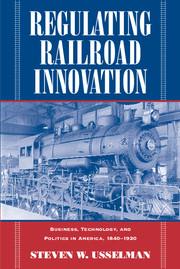Part II - RUNNING THE MACHINE, 1876–1904
Published online by Cambridge University Press: 12 August 2009
Summary
The grand developmental epic of American railroading reached its denouement with the extraordinary postbellum boom of the Northern and Western economy. The ensuing financial collapse of the mid-1870s ushered in a dramatically different era. No longer able to reap the easy bonanza initially made possible by the marriage of railroad technology to virgin land and resources, railroads faced increasingly intense competition for traffic that might travel over any of several highly capitalized routes. Government, which had long been a source of subsidy for railroads, now threatened them with regulation that would further intensify the pressures to cut fares and shave costs. Though new frontiers would open during the 1880s in the Pacific Northwest and to a lesser extent in the Gulf Coast region, the paramount concern of American railroading was now to utilize existing facilities fully and keep costs low. Railroads tried to attract a large and steady volume of traffic and push it through their network of tracks as smoothly as possible.
The passage from expansive development to operational stewardship dramatically altered the paths of technical change in the railroad industry. The new objectives imparted an emphasis on standardization and routine that often bordered on the obsessive. Managers sought to diminish the degree of personal autonomy that had long characterized railroad innovation and to impose order over their technical affairs through bureaucratic control.
- Type
- Chapter
- Information
- Regulating Railroad InnovationBusiness, Technology, and Politics in America, 1840–1920, pp. 141 - 142Publisher: Cambridge University PressPrint publication year: 2002



